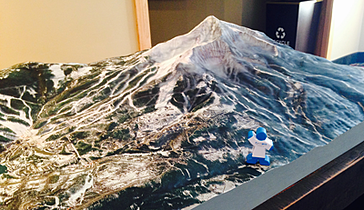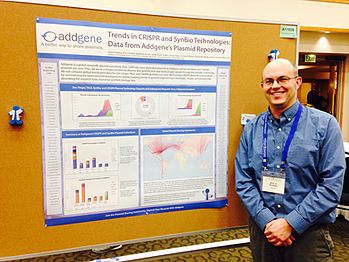 It's been about 14 years since I last attended a Keystone Meeting – far too long. Holding these meetings in relatively isolated resorts creates a sense of camaraderie with fellow attendees from the moment you arrive. Getting off the plane in Bozeman Sunday night, it was easy to spot meeting participants. They were the ones holding poster tubes (or as our baffled flight attendant called them, "long, skinny things") and generally exuding a very-tired-but-very-excited attitude. Riding up to the resort in the shuttle, our driver regaled us with tales of back country skiing, fly fishing, and local grizzly bear attacks. He described one such recent attack as "hilarious". Welcome to Montana!
It's been about 14 years since I last attended a Keystone Meeting – far too long. Holding these meetings in relatively isolated resorts creates a sense of camaraderie with fellow attendees from the moment you arrive. Getting off the plane in Bozeman Sunday night, it was easy to spot meeting participants. They were the ones holding poster tubes (or as our baffled flight attendant called them, "long, skinny things") and generally exuding a very-tired-but-very-excited attitude. Riding up to the resort in the shuttle, our driver regaled us with tales of back country skiing, fly fishing, and local grizzly bear attacks. He described one such recent attack as "hilarious". Welcome to Montana!
Though sadly I will not be attending the entire meeting, Monday's talks alone were worth the trip. Dr. Dana Carroll's excellent keynote address was the first of 19 talks given over the course of the day. His talk, which focused on the history of genome engineering from ZFNs through TALENs and CRISPR-Cas nucleases, provided important context for the rest of the day. He was followed by three of the biggest names in the CRISPR-Cas9 field – Jennifer Doudna, Feng Zhang, and Keith Joung. All Addgene depositors! Addgene was mentioned specifically in Dr. Zhang's introduction. His willingness to share reagents so freely with the academic community has clearly made a huge impact on this field.
Advances in genome engineering & CRISPR technology
That afternoon's workshop, entitled "Advances in Genome Engineering", brought us 8 short talks on every conceivable way of examining, modifying, and improving the CRISPR-Cas9 system. Mehmet Fatih Bolukbasi from Scot Wolfe's lab described a chimeric Cas9 that is improving the nuclease specificity dramatically and reducing off-target effects. Other young scientists discussed new CRISPR delivery systems, modifications to the RNA components, and challenging target genomes, such as the malaria-causing Plasmodium falciparum. Throughout these talks, I oscillated between amazement at how much has been done with CRISPR technology in just 2 years and excitement about how much more there is left to do with the characterization and implementation of this system.
Monday evening's talks switched gears (or should I say circuits?) to more parts-oriented synthetic biology. I've been answering biology customer service questions for nearly 7 years, and my colleagues and I have an internal motto for scientists who contact us and want a guarantee that their experiments will work (yes, this happens): Science is hard. Chris Voigt, another Addgene depositor, discussed some of the many challenges of creating biological circuits, and I can only say this science is really, really hard. That so many scientists are tackling this type of genetic engineering is a testament to how amazing the downstream payoff could be. Though I attended an engineering school as an undergraduate, I never fooled myself into thinking I was an engineer. The talks we heard Monday night represented engineering first and foremost, from the custom software used to design complex genetic circuitry to the downstream output. Tuesday morning's talks were also about circuitry and synthetic biology, and I found myself extremely grateful to my colleague Jason for choosing Simon Singh's "The Code Book" for this month's Addgene Book Club. I read most of the book on my way to the meeting, and its history of code making and code breaking is wonderfully analogous to genetic circuits discussed at this meeting. There are digital and analog versions of each, and Tim Lu even compared his "memory" gene codes to a Turing machine (also discussed in the book). These synthetic biologists are taking the "genetic code" to a new level, changing it from a puzzle to decrypt to a tool to be harnessed.
Sharing CRISPR, synbio, & more via Addgene

Addgene's addition to the poster session was a first for our repository, and I was proud to be responsible for sharing some of our data at this meeting. We weren't quite sure what to expect in terms of interest, but visitors to the poster were impressed to see how the numbers of plasmid genome engineering tools – both deposited and distributed – have changed so dramatically in the past 4 years. I kept busy for the whole poster session, talking to people from every conceivable background at the meeting. I appreciated all the feedback I received from scientists, from those who expressed gratitude for the role Addgene plays in plasmid sharing to those who were anxious to hear about what was coming next. I also got to show off our new CRISPR page (which describes how to plan your CRISPR experiment for our new CRISPR/Cas users) and updated Synbio page to people who were curious about these newest features of our website.
I want to offer a huge thanks to all the Addgenies who worked so hard to make this poster, offered suggestions and tips, and helped get me to this meeting. And of course, I want to thank the organizers of this meeting who have given the attendees an amazing opportunity to share their cutting edge science in increasingly important field.
Interested in Addgene's Keystone Poster?
- We'll be sharing the poster with our blog readers and on social media next week, so follow us on Facebook, Twitter, or subscribe to this blog.
Find more CRISPR and Genome Engineering Resources at our website:
Topics: Addgene News






Leave a Comment